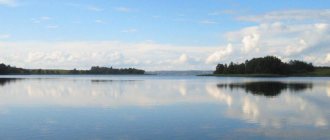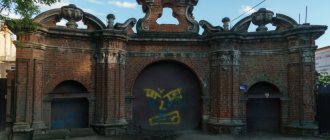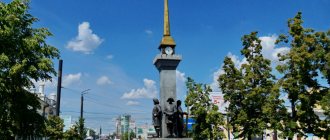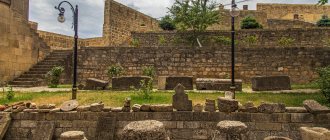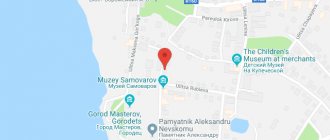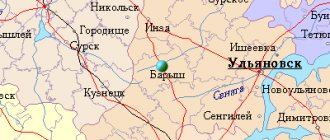Where to stay
Khabarovsk is stretched along the river. To explore it comfortably, it is better to stay in the center - otherwise it will take a lot of time to get from one end of the city to the other. It is most convenient to live within the boundaries of the “red square” - the zone in the center where the main attractions (and the most expensive real estate in the city) are concentrated.
On Booking.com, rooms in the most popular hotels - Olympic, Sopka and Khabarovsk City - cost from 4,000 rubles per night. A standard room in the iconic Amur Hotel will cost the same, but you should book in advance: it is always in high demand. The main reasons are the location in the center and a restaurant serving Far Eastern cuisine located in the same building.
If you want to save money, take a look at hostel rooms: they provide isolation from other guests and do not overpay for luxury. In Rent Rooms Barracuda, rooms cost from 1,600 rubles, in “Orion” - from 1,800. It will be even cheaper to rent a bed in a shared room: for example, in the “Court Room” it costs from 700 rubles per night.
The average option in terms of price and comfort is apartments. On Airbnb in the city center they will cost from 1,500 to 2,123 rubles per day. There are apartments both more expensive and cheaper, but located far from the center.
You can search for an apartment on Avito. There, the choice of daily rental housing is much larger than on Airbnb, but the site does not provide any guarantees for its clients. You should not transfer an advance payment for an apartment that you have not yet seen. Arrange for a viewing and only then make a decision.
Unique archaeological monuments
Scientists have established that the first settlements of ancient man arose on Khabarovsk land during the Mesolithic era. Since then, thousands of generations of people have left their traces in the local mountains and forests.
Petroglyphs of Sikachi-Alyan
- Coordinates: 48.753056, 135.645830.
Near the villages of Sikachi-Alyan and Malyshevo, on the banks of the Amur River, there are large basalt boulders with unique ancient designs. The stones depict people, animals, masks, boats, hunting scenes, various patterns and even horses that lived in the Amur region many centuries ago.
Amazing sculptures and paintings were made about 13,000 years ago, when a Nanai camp was located on the site of Sikachi-Alyan. Similar ancient creations can be found in other parts of the Khabarovsk Territory, but nowhere else is there such a variety of designs.
Bizarre images have been known for a long time, but scientists became interested in them only in the mid-19th century. Stone sculptures were first described in 1859 by the scientist R.K. Maak. The research of academician Alexei Okladnikov, published in 1935, brought them worldwide fame.
The significance of the monuments is recognized at the federal level; the steles have the status of objects of cultural heritage of the peoples of the Russian Federation. Also, stone creations can be included in the UNESCO World Heritage List.
Siziman stone forest
- Coordinates: 50.421963, 140.260902.
The unique natural phenomenon in Siziman Bay has been known since the 18th century. From a distance, the Stone Forest looks like an ordinary cliff overgrown with forest, but if you get closer to it, you can discern the outlines of ancient trees in the yellow wall.
Millions of years ago, cooling lava and volcanic ash sealed the plants forever, turning trunks and branches into stone sculptures. In 1992, the area was given the status of a natural monument.
Sukpai writing
- Coordinates: 47.958889, 136.965556.
Rock carvings on the banks of the Sukpai River were discovered relatively recently. On the steep rock that stands near the water itself, there are 11 petroglyphs made with brown ocher. Ancient drawings depict riders on horses and rowers in boats.
Experts estimate the age of the gallery at 3000 years; studies have shown that the first paintings were created at the beginning of the first millennium AD. The pisanitsa has been given a special status, as evidenced by the black plaque on the wall.
Kiinsky writings
- Coordinates: 47.971008, 135.172898.
Another famous rock gallery was found in the vicinity of the village of Pereyaslavka on the banks of the Kiya River. The Kiin paintings resemble the petroglyphs of Sikachi-Alyan: 13 images of masks and figures of birds and animals are carved into the rocks. Thousands of years ago, various rituals, such as initiation rites, were performed here.
Initially there were more petroglyphs, but some of them were destroyed by unknown vandals several years ago. The age of the archaeological site is approximately 5000 years.
Many of the drawings are surprisingly symmetrical; scientists suggest that they were created using special measuring instruments. The accuracy of these instruments indicates the high level of development of the tribe from which the ancient artists came.
You may be interested in the beautiful places of the regions neighboring the Khabarovsk Territory - Primorsky and Kamchatka Territories, Amur, Sakhalin and Magadan regions, the Republic of Sakha
Traveling around the Khabarovsk Territory promises brave tourists many discoveries and pleasant impressions. The region has conditions for active leisure; tourists can organize hikes in the most picturesque corners of the region, rafting down noisy rivers and climbing mountains and rocks.
What sights of Khabarovsk to see
Lenin Square
Address: st. Karl Marx, no. 56.
Photo: Beliakina Ekaterina / Shutterstock
This is the central square of Khabarovsk, from which it would be best to start a walking tour of the city. In the summer there are fountains, and in the evenings they turn on LEDs. In winter, the square is filled with ice and snow sculptures by participants in the Amur Crystal competition.
In 1873, when Khabarovsk was still called Khabarovka and the development of this territory was just beginning, a new cemetery was laid out on the site of Lenin Square. LENIN IN KHABAROVSK - instead of Innokentyevsky, which was close to the current embankment, very much in the center. In 1882, the new cemetery also had to be closed: the city was growing too quickly. In 1905, the square became the center of political events, and later the center of public life in Khabarovsk.
Now it is a walking area where it is nice to look at the fountains and eat ice cream. But when you stand on it, remember that in this very place there used to be a tent of a traveling circus, opponents of the tsarist government gave speeches, and even earlier human bones were buried.
Muravyov-Amursky Street
Photo: Konstantin Baidin / Shutterstock
It is called the city’s red line. The street, named after the founder of the city, Count Nikolai Muravyov, stretches from Lenin Square to the embankment. It incorporates a unique combination of architectural solutions: pre-revolutionary buildings stand side by side with Soviet buildings from different periods.
The best cafes are also located here. There are atmospheric coffee shops, Chinese restaurants, and burger joints. The most popular establishments among residents and guests of the city are those opened by Ronald and Jane, formerly Evgeniy and Olga, founders of the Khabarovsk cigar club. Their establishments are the Harley cabaret-saloon, the Italian pizzeria Vdrova, the Czech pub Pani Fasani, and the oriental restaurant Sultan Bazaar. Each place creates a unique atmosphere in which the food, drinks, interior and staff are immersed - real actors.
It is noteworthy that with their signs, establishments on the street do not worsen the impression of the architectural diversity of the buildings: local authorities are doing a lot to preserve this ensemble and not spoil it with banners.
Embankment
Address: st. Sovetskaya, Ussuriysky Boulevard.
Photo: Shiler / Shutterstock
Khabarovsk is one of the few cities in the Far East that has a long and beautiful walking area along the water. You can spend several hours here: just walk and enjoy the views of the Amur River, rollerblade and bike ride, listen to street musicians, look at the city from the Ferris wheel.
The embankment was one of the first in the city to receive a flood. Flood in the Far East in 2013 on the Amur in 2013. Then the water spilled over the lowlands of Khabarovsk, flooded residential buildings along the coastline and destroyed the amenities of the embankment. For several years it was closed to walks. During this time, it was further strengthened and finished with materials that are not afraid of water.
Cliff
Address: st. Shevchenko, 15.
Photo: Konstantin Baidin / Shutterstock
The building, which appears on the five thousand dollar bill, is located at the top of the embankment on a cliff. This is where the history of the city begins: in 1854, it was here that Count Muravyov-Amursky pointed his hand about what the old cliff was silent about, thereby outlining the location of the future city. However, long before the development of this territory by the Russians, the cliff was called the Old Woman's Mountain ("mother Khureeni") by the ancestors of the Nanai - the Golds, who inhabited the banks of the Amur, among other indigenous peoples. In the mountain, according to their ideas, there was a shaman’s dwelling.
The building itself on the top of the cliff appeared during the Great Patriotic War and was used to monitor the airspace. Nowadays, its observation deck offers views of the river below and the beautiful Khabarovsk sunsets, and inside there is a cultural museum, in the interior of which you can feel like a visitor to a secular salon of the century before last. Opposite the cliff stands a monument to Count Muravyov-Amursky.
Grodekov Museum
Address: st. Shevchenko, 11.
Photo: Beliakina Ekaterina / Shutterstock
The local history museum contains all the information about the history of the region, from the period of its development by indigenous peoples to the present day. It was opened back in Tsarist Russia through the efforts of the Amur Governor-General Nikolai Grodekov, who did a lot to educate local residents. At first, the museum was filled with exhibits donated by members of the Russian Geographical Society. Now there is everything you need to get acquainted with the history of the Khabarovsk Territory, even the skeleton of a fin whale, which was given to the museum by the owner of one of the first Far Eastern whaling fleets.
The museum's opening hours are on its website.
Spaso‑Preobrazhensky Cathedral
Address: st. Turgeneva, 24.
Photo: iztverichka / Shutterstock
One of the tallest Orthodox cathedrals in the country and the tallest in the Far East: the height of the domes is 83 meters, with crosses - up to 96 meters. Built according to the design of architects Yuri Zhivetyev, Nikolai Prokudin and Evgeny Semenov in 2001–2003. Divided into upper and lower temples, the observation deck offers views of the Amur Valley. Liturgies for Christmas and Easter are held here, from which video broadcasts are organized for all Orthodox residents of the Khabarovsk Territory.
Museum of the History of Amur bridge
Address: VOKhR, 1a.
Photo: Eva Mont / Shutterstock
To visit it you will have to travel far beyond the “red square”, but it is worth it. The main exhibit of the museum is a fragment of the “royal” bridge built in 1916, which was named Alekseevsky Museum of the History of the Amur Bridge in honor of the son of the last Russian Emperor Nicholas II. There are also electric and diesel locomotives from the early 1900s, a tank from the century before last, and a retro station building has been erected. From here you can see the current Amur Bridge.
Springs and waterfalls of the Khabarovsk Territory
The region's water attractions are not limited to lakes and rivers. The region also contains thermal mineral springs and noisy waterfalls.
Warm key
- Coordinates: 47.477770, 134.972381.
The mineral spring with the telling name Teply Klyuch is located about 20 kilometers from the city of Vyazemsky. The spring flows in the middle of the taiga on the slopes of the majestic Sikhote-Alin. The source is classified as thermal; even in winter the water temperature reaches 37 °C. The key forms a small lake in which tourists swim all year round.
It is believed that the spring has healing properties and can cure many diseases. In Soviet times, a small hydropathic clinic operated here. Currently, there is a modest wooden gazebo near the spring for relaxation and picnics.
Tumninsky mineral spring
- Address: Vaninsky district, Tumnin village, st. Komsomolskaya, 27.
Another famous thermal spring is located ten kilometers from the Tumnin station in the Vaninsky district. The attraction is located in a remote area on the slope of the Sikhote-Alin covered with evergreen forests. The hot spring was discovered more than a hundred years ago, and since then it has become a popular place for recreation and healing.
The source has been landscaped and a colorful tourist base has been built nearby, the territory of which is decorated with statues of lions on high stone pedestals and wooden figures of funny fairy-tale characters.
Source "Soloninsky"
- Coordinates: 50.997964, 132.819710.
The mineral spring in the Verkhnebureinsky district in the valley of the Soloni River is not as famous as other large springs, although its waters are enriched with hydrogen sulfide and help in the treatment of many diseases.
Due to its composition, the water has a specific smell, but at the same time it is very clean, transparent and warm. Since 1997, the spring and the surrounding area have been under state protection.
Laguna Somon
- Coordinates: 51.468056, 140.734722.
Along the entire coastline there are many truly magnificent bays, bays and lagoons, but one lagoon - Somon - is in particular demand among tourists. The attraction occupies an area of more than 200 hectares in Chikhachev Bay near the village of De-Kastri.
The reason for its popularity is the huge reserves of valuable healing mud. Next to the rich deposit there is the only mud bath in the region, which can be visited at any time of the year.
Bear Waterfall
- Coordinates: 52.086623, 135.011793.
The undeniable beauty of Bear Lake is emphasized by the magnificent waterfall located at the mouth of the river that flows from the reservoir. Bear, or Unexpected, is one of the largest waterfalls in the region, its height exceeds 70 m.
Dazzling white foamy streams run loudly down gray-pink ledges in the rock and continue their way through the picturesque canyon. In December, severe frosts turn the waterfall into a huge ice wall.
Be sure to see the sights of individual cities of the Khabarovsk Territory - Khabarovsk, Komsomolsk-on-Amur, Amursk and Bikin
Where else to go in Khabarovsk
Architect's House
Address: st. Mostovaya, 2b.
Photo: Suvorov_Alex / Shutterstock
The unfinished building from which the photograph of the Amur Bridge for the five-thousandth banknote was taken. The structure has many names - the Crow's Nest, the House of the Architect, the Tower of Infidel - and is shrouded in many legends. According to one version, it was built by the NKVD for prison purposes, and the secret mission was to conduct experiments with chemical weapons: this was stated by the former owner of the building, Vladimir Oleinikov, who allegedly found equipment of unknown purpose and many barrels in the underground premises.
According to another version, the building was connected to a railway tunnel under the Amur, and the huge tanks located next to it were supposed to be filled with water and thrown into the tunnel in case of a fire. A legend arose that the architect of the tunnel built this house for himself - and committed suicide here when, on the appointed day, two teams digging underground from both sides did not converge at one point.
The real history of the purpose of the building is hidden under the heading of secrecy. One thing is certain: its construction was interrupted after the Great Patriotic War, during the conflict with the Japanese, when it became clear that the structure could become a good target for shelling. Now the building is surrounded by a fence, but there is access to the hill itself, and from there there is a gorgeous view of the Amur Bridge.
Khabarovsk Regional Philharmonic Society
Address: st. Shevchenko, 7.
Photo: Konstantin Baidin / Shutterstock
This is the home of the Far Eastern Symphony Orchestra, which has been performing under this name since 1966 and has become a legend far beyond the borders of the Far Eastern Federal District. For more than 80 years, the Khabarovsk Regional Philharmonic has hosted the country's leading orchestras, giving city performers the opportunity to perform, and every season the symphony orchestra comes up with something fundamentally new for listeners.
You can view the concert schedule on the Philharmonic website.
Center for Contemporary Art "Artservatory"
Address: st. Lev Tolstoy, no. 3.
View this post on Instagram
Posted by Artservatory (@_artservatory_)
Here they talk in simple language about classical and contemporary art, place exhibitions of local and Western Russian artists, hold film screenings with professional analysis of what they saw, organize interactive exhibitions and sell cool merchandise with prints on the theme of Khabarovsk from young designers of the city.
The current schedule of exhibitions and planned events is available on the Artservatory’s Instagram page.
"Brosko Mall"
Address: st. Pionerskaya, 2v.
Photo: Brosko Mall Facebook group
The first European-style shopping center in Khabarovsk. It combines boutiques of world brands with the best stores of local entrepreneurs. But shopping is not the only thing to do here: visitors can listen to a performance by the Far Eastern Symphony Orchestra, attend a lecture on contemporary art, take part in a film screening, or simply read a book overlooking the Amur Valley.
You can view the schedule of upcoming events at Brosco Mall on the shopping center’s Instagram page.
City ponds
Address: Ussuriysky Boulevard.
Photo: Beliakina Ekaterina / Shutterstock
A walking area with three ponds and a green area carefully protected from interference by builders. An island of nature in the center of the city - however, Khabarovsk is already all covered with greenery, this is carefully monitored. The ponds have attractions for children, ice cream stands, and catamarans that you can ride on in the summer. There is a musical fountain on one of the ponds during the warm season, and a laser show is shown in the evenings.
Museum "World of Talking Machines"
Address: st. Frunze, 50.
View this post on Instagram
Posted by WORLD OF TALKING MACHINES (@talkmachines) May 25, 2022 at 6:49 am PDT
A private museum, one of the few in the Far East and generally the first music museum to open here. Born from the private collection of players and audio media of Andrey and Evgenia Veretennikov. In their opinion ABOUT THE MUSEUM, music during the development of the Far Eastern territories by settlers became the language in which people spoke with their native land. The museum's exposition is located in three halls: “Vintage”, “USSR” and “Disco”.
The museum is open to visitors upon private request. You can sign up for a tour through the contacts listed on the website.
Muravyov-Amursky Park
If you are making a list of places to go in Khabarovsk, add Muravyov-Amursky Park to it. It stretches from Komsomolskaya Square along the Amur embankment. Among the attractions is a bronze monument to N.N. Muravyov-Amursky, under whom the Amur region and Primorye became part of the map of Russia. The project of the monument in honor of the East Siberian Governor-General was approved by Alexander III himself. Now in the park there is not the monument itself, the work of the sculptor A.M. Opekushin, but only his replica: in 1925 the sculpture was melted down, and a copy was created based on the model preserved in the museum.
The park is equipped with a stage and a gazebo for an orchestra, and if you're lucky, you can go to a festival or concert - they are held regularly from May to September.
The park offers a picturesque view from above of the Amur and the Sikhote-Alinsky ridge. You can go down two wide staircases to the Nevelskogo embankment.
What to bring from Khabarovsk
Red caviar
It has become one of the gastronomic symbols of the entire Far East. It is used in Far Eastern cuisine in restaurants, and at home it is simply spread on bread. Red caviar brought back from your trip is perfect proof that you have visited the harsh Far Eastern land. Red caviar is sold in many grocery stores in the city, as well as in the central market.
T-shirt with print from Khabarovsk designers
Respect the artist - take with you something with his work. In Khabarovsk, T-shirts, hoodies, and postcards with drawings by local designers are sold - an excellent reminder of the city both for you and for any resident of Khabarovsk who has left. You can buy city merchandise at the Artservatory or at the Plankton store.
Photo “like on a five thousand dollar bill”
You have a choice between two locations where you can take such a photo. Choose the side that you like best and go either to the cliff or to the hill near the Amur Bridge, where the House of the Architect is located.
Traditional souvenirs
The city sells souvenirs in the form of household items of the indigenous peoples of the Khabarovsk Territory. If you are inspired by the history of the development of this territory and you are impressed, for example, by Nanai symbolism, go to the “Secrets of Craft” store on Muravyova-Amursky.
Try Pan-Asian cuisine
Of course, we must not forget about more material things, such as food. If in any seaside city you definitely need to fill up on seafood, then in Khabarovsk you need to eat Chinese, Korean, Vietnamese and other pan-Asian food.
Chinese cuisine is still the most developed here - this is not surprising; neighboring China can be reached here in 1.5 hours by boat. Chinese boxes, sweet and sour sauces, egg noodles, funchose (not the usual thin threads mixed with carrots or cucumbers for Yekaterinburg residents, but real thick noodles) and other delights generously flavored with monosodium glutamate (a flavor enhancer is a must-have ingredient in Chinese cuisine) can be found here literally on every corner.
One of the many Asian restaurants
In Khabarovsk , they replace large American fast food franchises that never made it here, so you can buy dishes quite cheaply. But there are also more reputable restaurants of Pan-Asian cuisine, where you can try udon, clogs or ramen, instead of the ubiquitous sushi and rolls. And pyan-se - a traditional Korean steamed cabbage and meat pie - can be found in any, even the most seedy, grocery store.
In addition to traditional Asian , in Khabarovsk you can find many unusual drinks, sweets, snacks and alcohol with hieroglyphs on the label. For example, you can easily find candy made entirely from ginger, drink tea that contains rice, eat nori chips or other snacks from well-known brands, but with flavors that are rare for Russia (for example, chips with Yuzu pepper and citrus flavors).
Far Eastern Art Museum
Rising from Muravyov-Amursky Park, we find ourselves on Shevchenko Street, where an art museum is located in the building of the former Officers' Assembly. It houses the largest collection of fine art in the Pacific region. The museum was formed starting in 1931 on the basis of receipts from the storerooms of the Hermitage, Pushkin and Russian museums, and the Tretyakov Gallery. Works of portraiture, icon painting, French and Italian engravings, and folk crafts of the Far Eastern aborigines await connoisseurs of beauty. Here you can see paintings by I. Aivazovsky and drawings by A. Benois, works by Titian and etchings by Rembrandt.
You can visit this museum in Khabarovsk every day except Monday. It also works on holidays, excluding January 1 and 7. An adult ticket costs 250 rubles, a discounted ticket for pensioners and students costs 60. Under 16 years of age, admission is free.
For those interested in the culture of the Amur aborigines, there is a branch in the village of Sikachi-Alyan.
Admiral Nevelskoy Embankment
The city could not forget the legendary admiral, who predetermined the location of the future Khabarovsk back in 1854. The embankment was named in honor of the explorer of the Far Eastern lands, which became a real landmark. Stretches from the River Station to the stadium. Lenin. Now this is one of the best vacation spots in Khabarovsk, which is a must-visit.
The embankment is decorated with a monument to the writer N.P. Zadornov (the famous satirist was his son). Here is a monument to the soldiers of the 13th East Siberian Line Battalion.
You can get to the embankment from Komsomolskaya Square (the 1st trolleybus, buses No. 1, 1L go to it).
Northern Park
People come here to walk with their children, take photos and breathe fresh air in the shady alleys. They also visit the Temple of Seraphim of Sarov: according to urban legend, miracles of healing from illnesses occur in the temple, built in 2008.
Rotundas and flower beds, a medieval castle under construction with a tournament ground and wooden sculptures - this is the appearance of the park. Its main highlight is the ponds with ducks and fish. The latter can be caught by paying 500 rubles. for three hours of fishing.
You can get to the park by going to the Technical University stop and walking 600 m.
